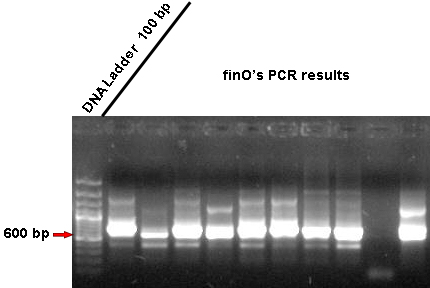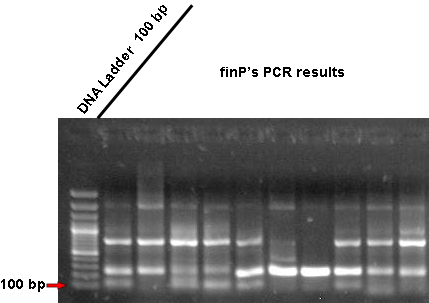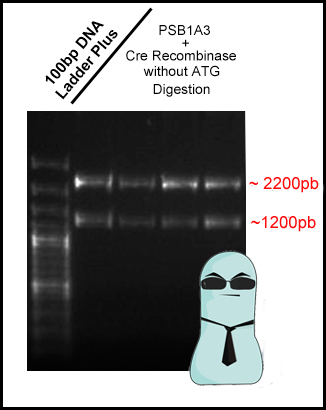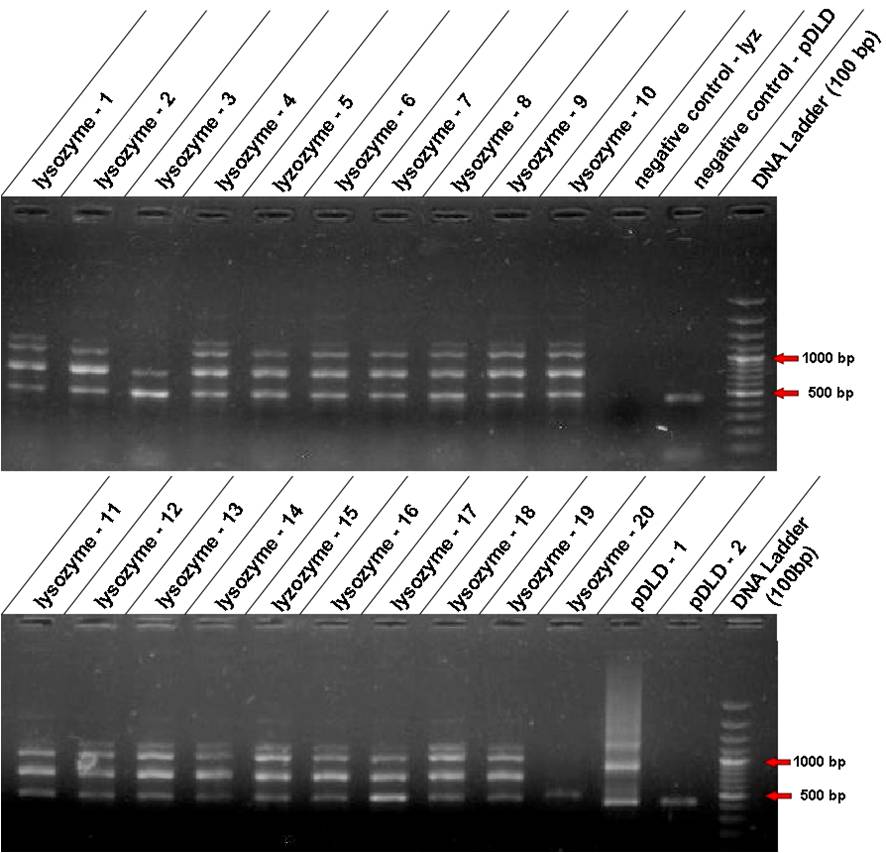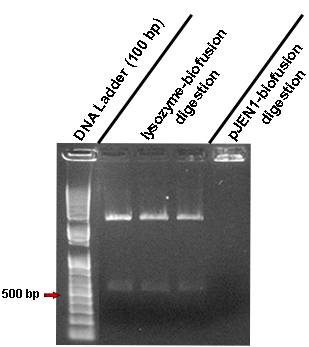Team:UNICAMP-Brazil/Notebooks/October 10
From 2009.igem.org
(→ADH1 promoter characterization) |
Victor.negri (Talk | contribs) (→Cre-Recombinase - Confirmation: Stage II) |
||
| (23 intermediate revisions not shown) | |||
| Line 1: | Line 1: | ||
| - | |||
{{:Team:UNICAMP-Brazil/inc_topo}} | {{:Team:UNICAMP-Brazil/inc_topo}} | ||
{{:Team:UNICAMP-Brazil/inc calendar}} | {{:Team:UNICAMP-Brazil/inc calendar}} | ||
| Line 6: | Line 5: | ||
| - | ==''' | + | ==''' ColiGuard '''== |
| - | ==== | + | ====Transformation of the BBa K112806 + BBa B0015 ligation==== |
| - | + | ||
| - | + | ||
| - | + | ||
| + | *<p style=”text-align:justify;”>We purified the digestion from agarose gel and use the product to do a ligation with BBa B0014 + BBa K112806 according to [https://2009.igem.org/Team:UNICAMP-Brazil/Protocols/T4_DNA_Ligase Protocol 11].</p> | ||
| - | '' | + | *<p style=”text-align:justify;”>The ligation was used in the transformation of ''E. coli''. We hope with BBa B0014 the digestion is better than B0015.</p> |
| - | |||
====finO and finP with pGEM - confirmation==== | ====finO and finP with pGEM - confirmation==== | ||
| - | * Once we confirmed that several samples actually have finO and finP inserts ligated into pGEM vector (by the digestion procedure performed yesterday), we could proceed to the final step on confirming our finOP-pGEM ligations. | + | *<p style=”text-align:justify;”>Once we confirmed that several samples actually have finO and finP inserts ligated into pGEM vector (by the digestion procedure performed yesterday), we could proceed to the final step on confirming our finOP-pGEM ligations.</p> |
| - | * We performed a PCR for each miniprep samples we got, using a specific forward primer for our inserts (finO and finP) and a reverse primer that is specific for pGEM vector (primer M13, see pGEM manual). This will allow us to verify that we have the insert ligated into the plasmid and, further more, will allow us to check whether or not our inserts are indeed in the correct frame position. | + | *<p style=”text-align:justify;”>We performed a PCR for each miniprep samples we got, using a specific forward primer for our inserts (finO and finP) and a reverse primer that is specific for pGEM vector (primer M13, see pGEM manual). This will allow us to verify that we have the insert ligated into the plasmid and, further more, will allow us to check whether or not our inserts are indeed in the correct frame position.</p> |
[[image:confirmacaoPCR1010finOpGEM.jpg|center]] | [[image:confirmacaoPCR1010finOpGEM.jpg|center]] | ||
| Line 30: | Line 26: | ||
| - | * According to the pictures, both finO and finP's PCR resulted in bands that reached the expected size in several samples. | + | *<p style=”text-align:justify;”>According to the pictures, both finO and finP's PCR resulted in bands that reached the expected size in several samples.</p> |
| - | * Therefore, we concluded we sucessfully have finO and finP correctly ligated into pGEM vector. Next step is ligating them into biobrick's vector. | + | *<p style=”text-align:justify;”>Therefore, we concluded we sucessfully have finO and finP correctly ligated into pGEM vector. Next step is ligating them into biobrick's vector.</p> |
| - | + | ||
''Marcelo'' | ''Marcelo'' | ||
| + | ==== PY Promoter - Mini-prep and digestion reaction ==== | ||
| + | |||
| + | *<p style=”text-align:justify;”>Today we performed mini-preps ([https://2009.igem.org/Team:UNICAMP-Brazil/Protocols/Mini-Prep Protocol 2]) to extract the plasmids from the selected colonies inoculated yesterday.</p> | ||
| + | |||
| + | *<p style=”text-align:justify;”>After plasmid extraction it was digested with XbaI and PstI to remove the PY1 promoter with the RFP reporter.</p> | ||
| + | |||
| + | *<p style=”text-align:justify;”>Now we are going to insert this removed fragment in 2 types of plasmids:</p> | ||
| + | |||
| + | <p style=”text-align:justify;”>- BBa_J23100 again. Our intention is to recover the NotI restriction site between the EcoRI and XbaI sites. So we are going to reinsert the fragment digested with XbaI and PstI into the plasmid digested with this 2 enzymes. After the insertion our fragment is going to be a biobrick! =)</p> | ||
| + | <p style=”text-align:justify;”>- BBa_B0015. We are going to perform our tests with a conjugative strain. We then need to insert our plasmid in this strain, so we will be able to analyze the activation of PY promoter during conjugation. However, the conjugative strain available to us already has ampicilin resistance. So we need to have our construction (PY promoter + RFP reporter) in a plasmid that has another type of resistance to be possible to select the colonies that acquired our plasmid after we transform the conjugative strain with it. We selected the plasmid BBa_B0015, that has ampicilin and kanamycin resistance. We also digested this plasmid with XbaI and PstI.</p> | ||
| + | |||
| + | *<p style=”text-align:justify;”>These 3 digestion reactions lasted for 3 hours.</p> | ||
| + | |||
| + | ''Fabi and Léo'' | ||
| + | |||
| + | ====Cre-Recombinase - Confirmation: Stage II==== | ||
| + | |||
| + | *<p style=”text-align:justify;”>Now that stage I was successfully succeeded, today we performed stage II on confirming our Cre's biobrick. We performed a digestion of four of the samples confirmed in stage I, using ''XbaI'' and ''SpeI'' restriction enzymes.</p> | ||
| + | *<p style=”text-align:justify;”>Digestion lasted 3 hours. We then ran an 1% agarose gel, in order to confirm that the digestion actually worked.</p> | ||
| + | *<p style=”text-align:justify;”>Finally, according to stage II...... yeah! it worked! We found two bands in all digested samples: one reaching 2200 bp (pSB1A3 vector) and other reaching 1200 bp (Cre-Recombinase).</p> | ||
| + | |||
| + | |||
| + | [[image:Cre_final.jpg|center]] | ||
| + | |||
| + | |||
| + | *<p style=”text-align:justify;”> We finally got a biobrick! Cre-Recombinase without ATG's biobrick now done! Next step will be assembling the entire device (see Differentiation Mechanism under Coliguard section for further information). | ||
| + | |||
| + | ''Víctor'' | ||
| + | |||
| + | ==''' YeastGuard '''== | ||
| + | ====[https://2009.igem.org/Team:UNICAMP-Brazil/Protocols/pGEMStrategy New Strategy: pGEM]==== | ||
| + | * The plate of ''E. coli'' transformed with the pDLD+Biofusion had only two colonies. We did the colony PCR to find correct constructions of the pDLD and Lysozyme in Biofusion. We found two fragments corresponding to pDLD, but the negative control amplified the same fragment too! We decided to do miniprep of both colonies and re-confirm it by digestion. | ||
| + | |||
| + | * We found one expected band of lysozyme. We did miniprep of this colony and chose an inespecific one as well. | ||
| + | [[Image:lisozima1-20.jpg|600px|center]] | ||
| + | |||
| + | * JENorf+pGEM grew!! Later that day we found out that we forgot to plate X-Gal =/ We did more plates, this time with X-Gal!! Waste of time!! =( | ||
| + | |||
| + | * We digested the Lysozyme+Biofusion vector and pJEN1+Biofusion vector with ''Xba''I and ''Pst''I to recover the part fragment with one ''Not''I site. The Lysozyme digestion worked so we purified the correct fragment, ligated it in biofusion again in order to recover the second ''Not''I site. Unfortunately the pJEN1 digestion didn’t work. | ||
| + | [[Image:lisozima-biofusion.jpg|300px|center]] | ||
| + | |||
| + | * We inoculated pJEN1+biofusion and pDLD+biofusion in liquid media to do miniprep tomorrow. | ||
| + | |||
| + | ====pADH1+YFP==== | ||
| + | * An electrophoresis was made with the product of the digestion performed yesterday. Then, we purified the bands corresponding to the size of the pADH1 in the biofusion vector and the YFP part. | ||
| + | |||
| + | * So we made the ligation of the YFP part in the biofusion vector that contains the ADH1 promoter. Then we transformed this construction in ''E. coli'' that has grown O/N in the kanamicin media plate. | ||
| + | |||
| + | ''Wesley and Gleidson'' | ||
| + | |||
| + | ====YEP358==== | ||
| + | |||
| + | * We had positive colinies with YEP358-β -galactosidase ! | ||
{{:Team:UNICAMP-Brazil/inc_rodape}} | {{:Team:UNICAMP-Brazil/inc_rodape}} | ||
Latest revision as of 02:39, 22 October 2009
| ||||||||||||||||||||||||||||||||||
 "
"









